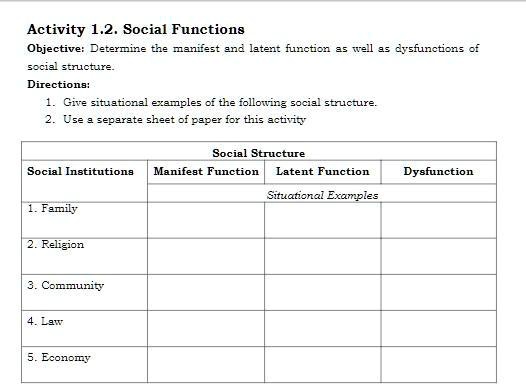Have you ever stopped to consider the unseen forces at play shaping our everyday lives? We might think of things like laws, institutions, and social norms as simply existing to maintain order and progress. But what if there’s more to it than meets the eye? Sociologists have a fascinating framework to understand these forces: the concept of manifest and latent functions.

Image: www.c4edu.org
Imagine a school. Its manifest function – the obvious, intended purpose – is to educate students. But beneath the surface, schools also play a vital role in socializing children, preparing them for the workforce, and even serving as childcare for working families. These less obvious, unintended consequences are called latent functions, and they highlight the complex ways social systems impact individuals and society as a whole.
Unveiling the Manifest: The Explicit Goals
The term “manifest function” refers to the recognized and intended consequences of a social institution or phenomenon. It’s what we explicitly aim to achieve. For instance, the manifest function of marriage is to establish a legal and socially recognized union between two individuals, often with the intention of raising a family, sharing resources, and providing mutual support.
Here are some more examples of manifest functions:
- Hospitals: Providing medical care and treatment to patients.
- Government: Maintaining law and order, providing public services, and ensuring national security.
- Religion: Offering spiritual guidance, promoting moral values, and connecting people to a higher purpose.
Delving into the Latent: Hidden Consequences
Latent functions are the unintended consequences of social institutions or phenomena. They’re often less obvious and can be both positive and negative. They highlight the unforeseen ways social systems shape our lives. Consider a university. Its manifest function is to educate students and prepare them for future careers. However, its latent functions can be numerous and varied:
- Networking: Universities provide a space for students to build professional connections that can benefit them later on.
- Delayed entry into workforce: Education serves as a kind of “holding pattern” for individuals, keeping them out of the workforce until they are considered prepared.
- Social change: Universities can become hubs for activism and social movements, driving societal progress.
Here are some more examples of latent functions:
- Social media: While intended for communication, it has also become a breeding ground for misinformation, cyberbullying, and addiction.
- Prisons: While meant to punish and rehabilitate, they can also foster criminal networks and increase recidivism rates.
- Sports: While aiming to promote physical fitness and competition, they can also reinforce gender stereotypes and contribute to the glorification of violence.
Historical Roots of a Powerful Concept
The concept of manifest and latent functions finds its roots in the work of sociologist Robert K. Merton, who introduced it in his 1949 publication, “Social Theory and Social Structure.” Merton aimed to provide a framework for understanding the functionalist perspective in sociology, emphasizing the interconnectedness of social structures and their impact on society.
Merton argued that social phenomena are often more complex than they appear. By analyzing both the intended (manifest) and unintended (latent) consequences, we can gain a deeper understanding of how social systems operate and how they affect our individual experiences. Merton’s work provided a powerful lens for studying everything from social institutions like education to social phenomena like race relations.

Image: www.numerade.com
The Interplay of Manifest and Latent Functions
Understanding both manifest and latent functions is crucial for developing a nuanced perspective on social issues. Recognizing the unintended consequences of social systems allows us to address potential problems and improve societal outcomes. For example, recognizing the latent function of social media in perpetuating misinformation has led to efforts to combat fake news and promote media literacy.
It’s important to remember that manifest and latent functions are often intertwined. What might seem like an intended consequence could also have unintended outcomes, and vice versa. For instance, the manifest function of a law might be to protect public safety, but it could also have the latent function of disproportionately affecting marginalized communities.
Implications for Social Change
The concept of manifest and latent functions has significant implications for social change. By analyzing both the intended and unintended consequences of social policies, we can identify potential problems and design more effective solutions. For instance, understanding the latent function of education in perpetuating social inequality can lead to initiatives aimed at promoting greater equity in access to learning opportunities.
Moreover, by recognizing that even seemingly benevolent social institutions can have negative unintended consequences, we can become more critical thinkers and advocates for social justice. We can challenge the status quo and work towards creating a society that is more equitable and just for all.
Beyond the Basics: A Framework for Critical Thinking
The concept of manifest and latent functions extends far beyond the realm of sociology. It provides a powerful framework for critical thinking in a variety of contexts, from examining the impact of new technologies to analyzing the consequences of political decisions.
By questioning assumptions and considering both intended and unintended consequences, we can gain a deeper understanding of the world around us and identify opportunities for positive change. Whether it’s understanding the impact of social media on our mental health or analyzing the potential consequences of a new environmental policy, the framework of manifest and latent functions empowers us to think critically and engage with complex social issues.
What Are Manifest And Latent Functions
https://youtube.com/watch?v=LcluY6UsVXY
Conclusion: A Deeper Understanding for a Better World
Exploring the concepts of manifest and latent functions provides a deeper understanding of the complexities of social systems and their impact on our lives. By recognizing both the intended and unintended consequences of our actions, we can become more responsible citizens and contribute to a more just and equitable world. So the next time you encounter a seemingly straightforward social phenomenon, take a moment to consider the unseen forces at play. You might be surprised by what you discover.
We encourage you to explore further resources on the topic of manifest and latent functions and share your thoughts and experiences in the comments below. Let’s continue to learn and grow together!





